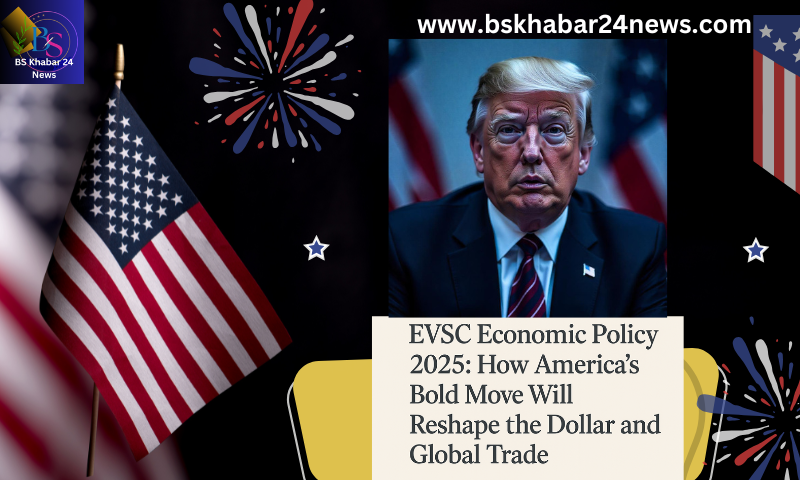U.S. Unveils EVSC Strategy to Reshape Dollar Dominance and Global Trade
The U.S. government presented its EVSC economic policy(EVSC Economic Policy 2025), a comprehensive plan aimed at changing trade, currency dynamics, fiscal stability, and, quite literally, how the dollar moves in international markets, in a surprising statement earlier today (August 4, 2025). People are already hailing this policy as revolutionary.
What Is the EVSC Policy?
EVSC, or Economic Vision for Stability and Currency, is a recently developed abbreviation for an all-encompassing strategy that combines:
1. Trade and tariff reforms—a significant revision of tariffs.
2. Restructuring the fiscal-monetary system, including ideas such as gold-backed debt securities.
3. Stabilising U.S. reserves and international trust in the dollar through new investment and structural regulations.
Despite being new, these components are part of the Trump-era trade strategy, which has been expanded and formalised.
Key Elements of the Policy ( EVSC Economic Policy 2025)
-
A significant increase in tariffs
The United States implemented a 10% duty on imports from around 180 countries on April 2, 2025, which was dubbed “Liberation Day.” This increased effective tariff levels to about 22%, the highest since 1909, The S&P 500 lost trillions, oil fell, and global risk-off trading spiked as a result of this surprise hammer strike, which drove markets into immediate panic.
-
Depreciation rather than appreciation of the dollar
Contrary to textbook expectations, the dollar dropped quickly following the tariff announcement, as advanced economies (G10) shifted away from dollar‑denominated assets and rebalanced portfolios . Rising uncertainty and eroded trust in the United States’ safe-haven status are reflected in this peculiar dynamic.EVSC Economic Policy 2025.
-
Examination of Treasury debt backed by gold
In order to restore fiscal restraint, lower interest rates, and establish a buffer against inflation—all while preserving dollar dominance—policy architects have proposed the audacious idea of issuing gold-backed government bonds by drawing on America’s gold reserves, which total more than 8,000 metric tonnes .
4. The UK-US Economic Prosperity Agreement
The United States and the United Kingdom signed a significant trade agreement on May 8, 2025, which significantly opened British markets to American exporters of beef, biofuels, and automobiles. The agreement also established quotas, such as granting 100,000 UK vehicles a 10% tariff instead of a 25% one. Although this offers some specific assistance, it is a part of the larger structure that is heavily reliant on tariffs.(EVSC Economic Policy 2025).
Why the Dollar Market Is Bracing for Impact
-
Quick fluctuations in exchange rates
When “Liberation Day” tariffs were imposed, millions of people scrambled to get protection. Contrary to expectations, the dollar dropped 1-2 percent versus the G10, which includes the euro, yen, pound, and franc, in a matter of hours. This was due to a combination of risk-averse behaviour and widespread foreign selling.(EVSC Economic Policy 2025).
• Currency markets being affected by equity volatility
Investor confidence was destroyed by escalating uncertainty. Dollar softness was a result of foreign investors rebalancing out of dollar assets when U.S. stocks dropped off more precipitously than global indices.
-
Slumping economic sentiment
There has been a sharp decline in consumer confidence. In March, the University of Michigan’s sentiment index fell 22% from December to 57.9. Soft macro data has lowered expectations for Fed interest rate support, and business outlooks have become extremely negative.
Why U.S. exceptionalism is being undermined by tariff policiesElevated tariffs have weakened the dollar’s prior strength by pinching company margins and lowering real family incomes, which Goldman Sachs analysts point to as a major dollar-weakening factor.
What’s Next: Implications for Stakeholders
Investors & Traders
Be prepared for increased FX volatility. Bond yields, plans for gold-backed instruments, and information on trade imbalances will all have an impact on currency markets.
Businesses & Exporters
Selective privileged access (for example, through the UK-US pact) may help American exporters, but many businesses may have to pay more for imports. Businesses that depend on international supply chains should account for the constant uncertainty of tariffs.(EVSC Economic Policy 2025).
U.S. Consumers
Price rises for imported items may result from higher tariffs. Although the gold-bond concept offers fiscal stability, it is unclear how it will affect inflation in the near future.
Policymakers & Academics
The volatility brought about by EVSC highlights more general theoretical boundaries, as conventional macro models were unable to forecast a decline in the value of the dollar following tariff increases. The dynamics of trade and currency may need to be rethought in this policy age.
Final Thoughts
The U.S. has initiated a massive set of structural economic changes with the implementation of the EVSC economic policy today. It combines aggressive debt reform concepts, high tariffs, and bilateral trade agreements into a daring—if disruptive—vision of how the dollar ought to function in international markets.
Already, markets are struggling with the consequences. Confidence is brittle, currencies are changing in strange directions, and economies are responding. It remains to be seen whether EVSC is a deliberate turn towards a more self-sustaining and disciplined financial future or a risky reversal of global economic interdependence.EVSC Economic Policy 2025.
Watch closely because every action, including bond sales, foreign exchange interventions, and trade talks, will either indicate that America is rewiring its economic system or that it is heading towards unexpected consequences.ture or a risky reversal of global economic interdependence.
